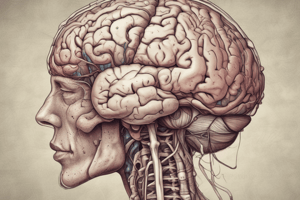Podcast
Questions and Answers
What is the primary function of the grey matter in the cerebral cortex?
What is the primary function of the grey matter in the cerebral cortex?
- Transmission of nerve impulses
- Myelination of axons
- Storage of memories
- Processing of sensory information (correct)
Which structure is involved in habit formation and reward-based learning?
Which structure is involved in habit formation and reward-based learning?
- Brain hemisphere
- Limbic system
- Cerebral cortex
- Basal ganglia (correct)
What is the primary function of the limbic system?
What is the primary function of the limbic system?
- Sensory perception
- Language processing
- Emotion regulation (correct)
- Motor control
Which brain hemisphere is responsible for language processing and analytical thinking?
Which brain hemisphere is responsible for language processing and analytical thinking?
What is the primary function of the parietal lobe?
What is the primary function of the parietal lobe?
Which lobe is involved in auditory processing and memory formation?
Which lobe is involved in auditory processing and memory formation?
Flashcards are hidden until you start studying
Study Notes
Cerebral Cortex
- The outermost layer of the cerebrum, responsible for processing sensory information and controlling movement
- Divided into four lobes: frontal, parietal, temporal, and occipital
- Composed of:
- Grey matter: neuronal cell bodies and dendrites
- White matter: myelinated axons
- Functions:
- Sensory perception
- Motor control
- Attention
- Memory
- Language processing
Basal Ganglia
- A group of structures located at the base of the cerebrum
- Involved in movement control and cognition
- Components:
- Caudate nucleus
- Putamen
- Globus pallidus
- Subthalamic nucleus
- Substantia nigra
- Functions:
- Motor control
- Habit formation
- Reward-based learning
- Cognitive flexibility
Limbic System
- A network of structures involved in emotion, motivation, and memory
- Components:
- Hippocampus
- Amygdala
- Hypothalamus
- Cingulate gyrus
- Fornix
- Functions:
- Emotion regulation
- Memory formation
- Motivation
- Arousal
Brain Hemisphere
- The cerebrum is divided into two hemispheres: left and right
- Each hemisphere is responsible for controlling the opposite side of the body
- Functions:
- Left hemisphere: language processing, logic, and analytical thinking
- Right hemisphere: spatial processing, creativity, and intuition
The Four Lobes
- Frontal Lobe
- Located in the front of the cerebrum
- Involved in:
- Motor control
- Executive functions (decision-making, planning)
- Language processing
- Parietal Lobe
- Located near the center of the cerebrum
- Involved in:
- Sensory processing (touch, spatial awareness)
- Attention
- Memory
- Temporal Lobe
- Located on the sides of the cerebrum
- Involved in:
- Auditory processing
- Memory formation
- Language processing
- Occipital Lobe
- Located at the back of the cerebrum
- Involved in:
- Visual processing
Studying That Suits You
Use AI to generate personalized quizzes and flashcards to suit your learning preferences.




